Got a new vehicle - or new to you? After you put the lift on, bigger tires and rock sliders, you still have a major task ahead of you. How do you get all that stuff you want to take in the vehicle?
Sure you can just make a big pile. The trick is how to organize it so it can be retrieved quickly (read that – move as little other stuff out of the way to put your hands on the item you want). And how can you store it safely and securely. Hit a big rock or flop your vehicle on the side, you want most (actually all!) of you gear to stay put.
Mandatory Quick Access
Make it a RULE to always have very and I mean very quick access to these items.

Shovel & Toilet paper

First aid Kit

Recovery Strap & D ring

Go Bag

Hammer (to setup your tent in the rain)
What else would you add to the list???
Outside Storage
As a rule anything that you can conveniently bolt on the outside of the vehicle, under the hood, or on the bumper is worth considering, because it saves space inside.
Under the hood, you ask? Sure! That’s a nice spot for an air compressor. This will not only save space inside your vehicle, it will also save setup time when you need the compressor. Certain tools, parts and fluids can be stored under the hood, as well. Be mindful of the warm temperature in there. Tape, hoses, and some fluids break down in extreme heat.
Just like lifts, tires, wheels, and armor there are a staggering number of options on the market from simple boxes to fully customized build in drawer systems.
If you have the money, now the time is ripe to finally decide on your rear bumper system. The right one can carry many items you want to get out of the interior space - shovel, jack, tire, gas and water.
If you are not sure what you want, start with two simple items – a roof rack and a shelf.
Roof Rack
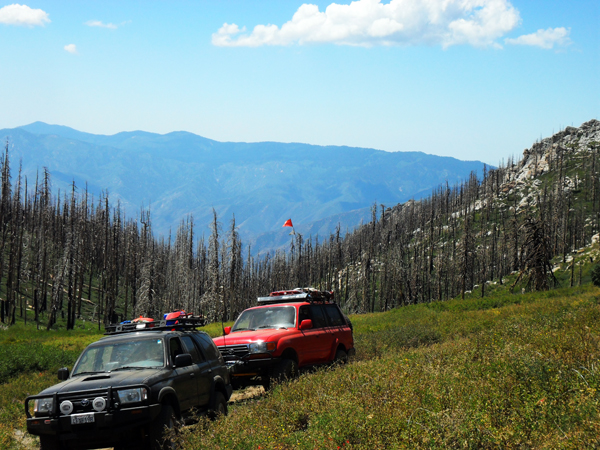
- StorageOptions003m.jpg (294.66 KiB) Viewed 2934 times
A roof rack can get bulky, odd shaped, dirty items out of your interior space. Fire wood, fire grate, BBQ, spare tire, pull pal, hi-lift, gas cans, and water cans all come to mind.
One drawback is that it can be difficult to lift and retrieve heavy objects. Bring a ladder. Get help if needed. I prefer to NOT put my Hi-lift jack on the roof rack. I will try anything to get my buddy to use his Hi-lift before attempting to bring mine off the roof rack.
Shelf
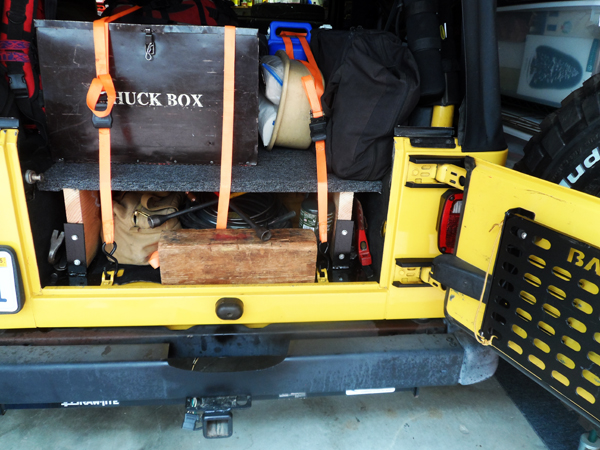
- StorageOptions002m.jpg (266.71 KiB) Viewed 2934 times
A shelf to divide the usable space in half is one of my first solutions. Want a simple, quick and temporary solution? Place two 2x10 (or 2x8, 2x12) boards the full length of the space (tail gate to the back of the seats) and cover it with a sheet of plywood. Find a way to attach the 2x10 to the floor and glue carpet on the plywood.
Be sure and tell yourself that this is only a temporary solution. But as a RULE: Temporary solutions tend to stick around for 5 years or more.
An unbelievable number of small bags containing heavy items can be stored under the height provided by a 2x10. This is the ideal place for tools, recovery gear, winch kit, spare parts, spare fluids, and 16 oz. propane bottles.
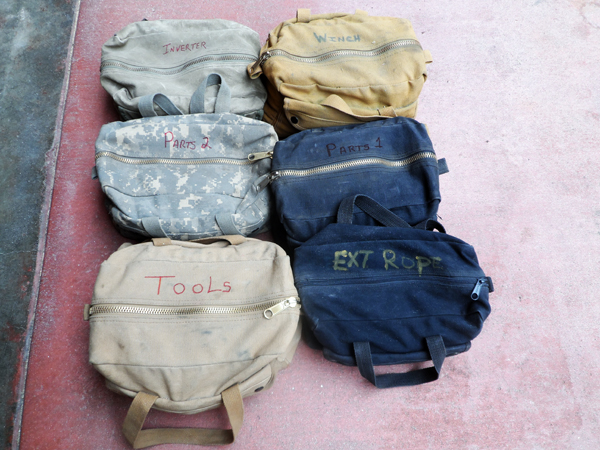
- StorageOptions001m.jpg (269.99 KiB) Viewed 2934 times
Organize so you can retrieve your stuff easily and quickly. For example, pack the most commonly used items within reach. Lesser used items can be buried toward the back of the shelf.
Typically most of the gear you put here will always stay in the vehicle.
Tie down your camping gear and other boxes on top of the shelf and you are good to go.
With a bit of thought, your shelf might even work to sleep inside the truck. Provided you don’t mind leaving a pile of gear outside at night for the bears.
Longer term, there are many manufacturers that offer products for purchase that are an improvement over this basic concept. The shelf will fit better, be lighter, and have trap doors or other unique ways to make use of space. They might even have built in drawers and sections that fold up and out of the way. I will leave the details to others on the net tonight.
Camp Box
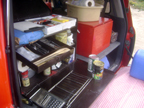
- Camping12ss.jpg (35.18 KiB) Viewed 2935 times
A fully functioning kitchen is a must. Without one, the trip could be a bust, regardless of the scenery and the climate.
The foundation of your kitchen is a camp box. Sometimes called a chuck box, the camp box contains many of the tools and non-perishable food items you’ll need. Compact and rugged, it fits neatly into your vehicle and withstands the rigors of off-road driving. When opened up, it offers just about everything you need to get started on your next meal. A camp box turns an ordinary vehicle in to a meals on wheels.
I purchased mine, but you can build your own. A quick internet search brings up links to numerous Web sites offering plans, including this one which offers a workbook for sale.
http://www.blueskykitchen.com/Grubby_One.html
Many folks use Pelican™ cases for camp boxes. Check out their large selection at
http://www.pelican.com. Someone else tonight will extoll their virtues more!
Regardless of whether you build or buy, make sure your box offers a sturdy flat work surface. On some models you can use the top. Others have a pull out shelf. Still others allow you to flip the box on its side and use the door as a work surface.
Keep in mind that your camp box isn’t just for camping. If you’re every forced to evacuate, your camp box will become a very important survival tool.
What’s in a camp box?
A camp box is as unique as its user. Still, certain essentials are found in nearly all. Those include pots and pans, plates and silverware, cups or glasses, large knives and spoons, matches or a lighter, and even a corkscrew. Add in some non-perishable food items such as coffee, tea, hot chocolate, cooking oil, flour, salt and pepper. Make sure they’re in small packages or containers. Use a separate box for larger quantities.
Over time, you will find the right combination for your needs.
No need to get fancy with the dishes. In fact, many people use hand-me-downs or goodies they found at garage sales. You’re going off-road, for crying out loud. Do you really want to pack your best stuff?
How many pieces of each you need depends on the size of your family and amount of space. Many people pack for a group of four. Take a few moments to calculate your needs. You can always revise that later.
Food Box
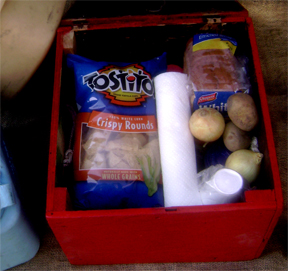
- Camping14.jpg (73.52 KiB) Viewed 2935 times
Next is a box of dry goods, condiments and related staples. These include paper towels or napkins, tin foil, cereal, and bulk quantities of various items in your camp box. Toss in a can or two of soup, tuna fish, and beef broth (if you like making soup). You may also want to include a roll of toilet paper and some handy wipes.